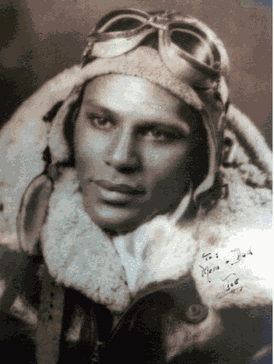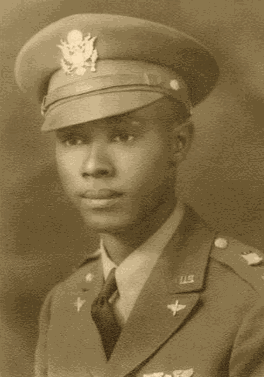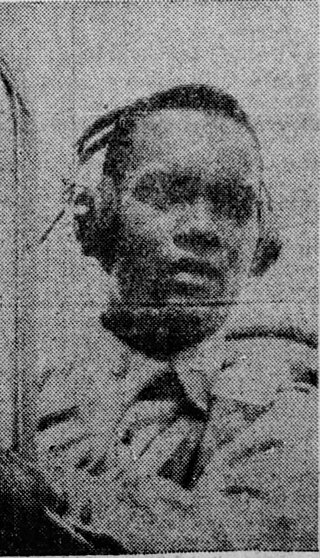Related Research Articles
The Tuskegee Airmen were a group of African American military pilots and airmen who fought in World War II. They formed the 332nd Fighter Group and the 477th Bombardment Group (Medium) of the United States Army Air Forces (USAAF). The name also applies to the navigators, bombardiers, mechanics, instructors, crew chiefs, nurses, cooks, and other support personnel. The Tuskegee airmen received praise for their excellent combat record earned while protecting American bombers from enemy fighters. The group was awarded three Distinguished Unit Citations.

Tuskegee Airmen National Historic Site, at Moton Field in Tuskegee, Alabama, commemorates the contributions of African-American airmen in World War II. Moton Field was the site of primary flight training for the pioneering pilots known as the Tuskegee Airmen, and is now operated by the National Park Service to interpret their history and achievements. It was constructed in 1941 as a new training base. The field was named after former Tuskegee Institute principal Robert Russa Moton, who died the previous year.

Charles Walter Dryden was a U.S. Army Air Force officer and one of the original combat fighter pilot with the 332nd Fighter Group's 99th Fighter Squadron,a component of the Tuskegee Airmen. Among the United States' first eight African American combat fighter pilots, Dryden is notable as a member of the Tuskegee Advance Flying School (TAFS)'s Class Number SE-42-C, the program's 2nd-ever aviation cadet program.

Sharpe Field is a closed private use airport located six nautical miles northwest of the central business district of Tuskegee, a city in Macon County, Alabama, United States. This airport is privately owned by the Bradbury Family Partnership.

Willa Beatrice Brown was an American aviator, lobbyist, teacher, and civil rights activist. She was the first African American woman to earn a pilot's license in the United States, the first African American woman to run for the United States Congress, first African American officer in the Civil Air Patrol, and first woman in the U.S. to have both a pilot's license and an aircraft mechanic's license.

John Charles Robinson was an American aviator and activist who was hailed as the "Brown Condor" for his service in the Imperial Ethiopian Air Force against Fascist Italy. Robinson pushed for equal opportunities for African-Americans during his early career, and was able to open his own eponymous aviation school in addition to initiating a program for black pilots at his college, the Tuskegee Institute. Robinson's achievements as an aviator were in stark contrast to the limited opportunities for most African-Americans in aviation careers, and were an important factor in reducing racially based prohibitions in the United States. Robinson is sometimes referred to as the "Father of the Tuskegee Airmen" for inspiring this all-black group of pilots who served in the United States Army Air Forces following the United States' entry into World War II.
Cornelius Robinson Coffey was an American aviator. Alongside Willa Brown, he was the first African American to create a non-university-affiliated aeronautical school in the United States.

Curtiss–Wright Aeronautical University was a flight school in Chicago, Illinois founded by aircraft manufacturer Curtiss-Wright. Open from 1929 until 1953, the university was the first accredited flight school in the Midwest which accepted black students and instructors. While it opened as an all-white school, after Cornelius Coffey and John C. Robinson threatened to sue the school for denying them entrance in 1930, the superintendent agreed to conduct segregated classes for black students if the two could prove that enough black students would enroll. The two founded the Challenger Air Pilots Association to develop the city's black aviation community, and by 1932 they had organized enough people to begin an all-black class. When the school lost access to its original airfield in 1933, its black students opened their own field due to the discrimination they faced at the city's other fields; originally located in the black community of Robbins, it later moved to 87th Street and Harlem Avenue in Chicago. The school's students played an important role in both developing Chicago's black aviation community and fighting for equality and the growth of black aviation nationwide. Aside from Coffey and Robinson, its notable alumni included Willa Brown, Janet Bragg, and several of the Tuskegee Airmen.
Robbins Airport, located in Robbins, Illinois, was the first airport to be owned and operated by African-Americans.
Joseph D. Elsberry (April 25, 1921 – March 31, 1985) was a U.S. Army Air Force officer and a prolific African-American World War II fighter pilot in the 332nd Fighter Group's 301st Fighter Squadron, best known as the famed Tuskegee Airmen, "Red Tails," or “Schwartze Vogelmenschen” among enemy German pilots. Elsberry destroyed three enemy aircraft over France in a single mission on July 12, 1944, and a fourth aircraft in July 20, 1944, becoming the first African American fighter pilot in history to do so. He is only one of four Tuskegee Airmen to have earned three aerial victories in a single day of combat: Clarence Lester, Lee Archer (pilot), and Harry Stewart.

Harold H. Brown (POW) was a U.S. Army Air Force officer who served during World War II as a combat fighter pilot with the 332nd Fighter Group, best known as the Tuskegee Airmen. Brown's P-51C aircraft was shot down in the European Theatre of World War II and he became a prisoner of war.

George Jewell Iles was a U.S. Army Air Force officer, former World War II Prisoner of War in Nazi Germany, and combat fighter pilot with the 332nd Fighter Group's 99th Fighter Squadron, best known as the all-African American Tuskegee Airmen.

Mac Ross was a U.S. Army Air Force officer and combat fighter pilot during World War II. A member of the Tuskegee Airmen, he commanded the 100th Fighter Squadron and served as the Group Operations Officer for the 332nd Fighter Group.

Sherman Windham White Jr. †) was a U.S. Army Air Force officer and combat fighter pilot with the all-African American 332nd Fighter Group's 99th Fighter Squadron, best known as the Tuskegee Airmen.

George Levi Knox II was a U.S. Army Air Force/U.S. Air Force officer, combat fighter pilot and Adjutant with the all-African American 332nd Fighter Group's 100th Fighter Squadron, best known as the Tuskegee Airmen. One of the 1,007 documented Tuskegee Airmen Pilots, he was a member of the Tuskegee Airmen's third-ever aviation cadet class, and one of the first twelve African Americans to become combat fighter pilots. He was the second Indiana native to graduate from the Tuskegee Advanced Flying School (TAFS).

James Thomas Wiley was a U.S. Army Air Forces/U.S. Air Force officer and combat fighter pilot of the 332nd Fighter Group's 99th Pursuit Squadron, best known as the Tuskegee Airmen or "Red Tails".
Graham "Peepsight" Smith † was an U.S. Army Air Force officer and combat fighter pilot with the 332nd Fighter Group's 99th Fighter Squadron, best known as the Tuskegee Airmen. He was a member of Tuskegee Airmen's fourth-ever aviation cadet program and one of the 1,007 documented Tuskegee Airmen Pilots.

Herman Albert "Ace" Lawson was a former Sacramento, California city councilman, Fresno State University football standout, highly decorated U.S. Army Air Force/U.S. Air Force officer, combat fighter pilot, and combat flight instructor with the 332nd Fighter Group's 99th Pursuit Squadron, best known as the Tuskegee Airmen or "Red Tails". He was one of 1,007 documented Tuskegee Airmen Pilots.

Wilmore B. Leonard was an American college professor, U.S. Army Air Corps/U.S. Air Force officer and combat fighter pilot with the 332nd Fighter Group. One of 1,007 documented Tuskegee Airmen Pilots, Leonard was a member of Tuskegee's sixth cadet graduating class and one of the first 50 African American combat fighter pilots. He served during World War II, retiring from the military in 1946. He subsequently attended the Howard University School of Dentistry, and became a dentistry professor, holding the position for 25 years.
William Noel Alsbrook, Sr. was an American inventor and combat fighter pilot with the 332nd Fighter Group's 99th Fighter Squadron, best known as the Tuskegee Airmen, "Red Tails," or "Schwartze Vogelmenschen" among enemy German pilots.
References
- ↑ "Willa Beatrice Brown" (PDF). Tuskegee Airmen Inc. Archived from the original (PDF) on 14 March 2017. Retrieved 3 April 2020.
- ↑ Heise, Kenan. "CORNELIUS COFFEY, EARLY BLACK AVIATOR". chicagotribune.com. Retrieved 3 April 2020.